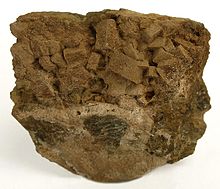숨-그림 자가조립
Breath-figure self-assembly
입김-그림 자가조립은 물방울의 응축에 의해 벌집형 마이크로-스케일 폴리머 패턴을 형성하는 자가조립 과정이다."호흡형상"은 수증기가 차가운 표면에 접촉할 때 생기는 안개를 말한다.[1][2][3]현대에는 숨막히는 물 응결 과정에 대한 체계적인 연구가 아이트켄과[4][5] 레일리에 의해 [6][7]진행되었다.반세기가 지난 후, 숨결 형성에 대한 관심은 대기 과정에 대한 연구라는 관점에서 되살아났고, 특히 이슬 형성에 대한 확장된 연구는 복잡한 물리적 과정으로 판명되었다.이슬 형성에 대한 실험적이고 이론적인 연구는 베이센스에 의해 수행되었다.[8][9][10]호흡 형상에 영감을 주는 폴리머 패턴의 형성을 이해하는 데 중요한 이슬 형성의 열역학적 및 운동학적 측면은 더욱 상세하게 다루어질 것이다.
호흡 구성 패턴의 적용에 있어 돌파구는 1994-1995년 위도스키, 프랑수아 및 피투아가 호흡 구성 응축 프로세스를 사용하여 자가 조직화되고 미세하게 크기가 조정된 벌집형 형태학으로 폴리머 필름의 제조를 보고하면서 달성되었다.[11][12]보고된 과정은 습기에 작용하는 빠르게 증발된 폴리머 용액에 기초하였다.[13][14][15]마이크로패턴 표면 제조에 관련된 실험 기법의 도입은 참고자료 1에 제공되었다. 전형적인 호흡 형상의 벌집모양 패턴을 나타내는 이미지는 그림 1에 나타나 있다.
그 과정에 관여하는 주요 물리적 과정은 1) 고분자 용액의 증발, 2) 물방울의 핵화, 3) 물방울의 응결, 4) 물방울의 성장, 5) 물의 증발, 6) 궁극적인 미세조직 패턴을 발생시키는 고분자의 고체화 등이다.[16]이 실험 기법은 잘 정돈된 계층적 벌집형 표면 패턴을 얻을 수 있다.[13][16]드랍-캐스팅, 딥-코팅, 스핀-코팅 등 호흡 형상 자가 조립 유도 패턴 형성에 다양한 실험 기법이 성공적으로 활용됐다.[2][15]호흡 구성 자체 조립에서 발생하는 계층적 패터닝이 보고되었다.모공의 특성 치수는 대개 1µm에 가까운 반면, 대형 패턴의 특성 측면 치수는 ca. 10–50µm이다.[2]
참고 항목
참조
- ^ Rodríguez-Hernández, Juan; Bormashenko, Edward (2020). Breath Figures: Mechanisms of Multi-scale Patterning and Strategies for Fabrication and Applications of Microstructured Functional Porous Surfaces. Cham: Springer International Publishing. doi:10.1007/978-3-030-51136-4. ISBN 978-3-030-51135-7.
- ^ a b c Yabu, Hiroshi (2018). "Fabrication of honeycomb films by the breath figure technique and their applications". Science and Technology of Advanced Materials. 19: 802–822. doi:10.1080/14686996.2018.1528478.

- ^ Zhang, Aijuan; Bai, Hua; Li, Lei (2015). "Breath Figure: A Nature-Inspired Preparation Method for Ordered Porous Films". Chemical Reviews. 115 (18): 9801–9868. doi:10.1021/acs.chemrev.5b00069. PMID 26284609.
- ^ Aitken, John (1893). "Breath Figures" (PDF). Proceedings of the Royal Society of Edinburgh. 20: 94–97. doi:10.1017/S0370164600048434.
- ^ Aitken, John (1911). "Breath Figures". Nature. 86 (2172): 516–517. doi:10.1038/086516a0.
- ^ Rayleigh, Lord (1911). "Breath Figures". Nature. 86 (2169): 416–417. doi:10.1038/086416d0.
- ^ Rayleigh, Lord (1912). "Breath Figures". Nature. 90 (2251): 436–438. doi:10.1038/090436c0.
- ^ Beysens, D.; Steyer, A.; Guenoun, P.; Fritter, D.; Knobler, C. M. (1991). "How does dew form?". Phase Transitions. 31 (1–4): 219–246. doi:10.1080/01411599108206932.
- ^ Beysens, D. (1995). "The formation of dew". Atmospheric Research. 39 (1–3): 215–237. doi:10.1016/0169-8095(95)00015-j.
- ^ Beysens, Daniel (2006). "Dew nucleation and growth". Comptes Rendus Physique. 7 (9–10): 1082–1100. doi:10.1016/j.crhy.2006.10.020.
- ^ Widawski, Gilles; Rawiso, Michel; François, Bernard (1994). "Self-organized honeycomb morphology of star-polymer polystyrene films". Nature. 369 (6479): 387–389. doi:10.1038/369387a0.
- ^ François, Bernard; Pitois, Olivier; François, Jeanne (1995). "Polymer films with a self-organized honeycomb morphology". Advanced Materials. 7 (12): 1041–1044. doi:10.1002/adma.19950071217.
- ^ a b Bunz, U. H. F. (2006). "Breath Figures as a Dynamic Templating Method for Polymers and Nanomaterials". Advanced Materials. 18 (8): 973–989. doi:10.1002/adma.200501131.
- ^ Muñoz-Bonilla, Alexandra; Fernández-García, Marta; Rodríguez-Hernández, Juan (2014). "Towards hierarchically ordered functional porous polymeric surfaces prepared by the breath figures approach". Progress in Polymer Science. 39 (3): 510–554. doi:10.1016/j.progpolymsci.2013.08.006. hdl:10261/98768.
- ^ a b Bormashenko, Edward (2017). "Breath-Figure Self-Assembly, a Versatile Method of Manufacturing Membranes and Porous Structures: Physical, Chemical and Technological Aspects". Membranes. 7 (3): 45. doi:10.3390/membranes7030045. PMC 5618130. PMID 28813026.
- ^ a b Srinivasarao, Mohan; Collings, David; Philips, Alan; Patel, Sanjay (2001). "Three-Dimensionally Ordered Array of Air Bubbles in a Polymer Film". Science. 292 (5514): 79–83. doi:10.1126/science.1057887. PMID 11292866.



